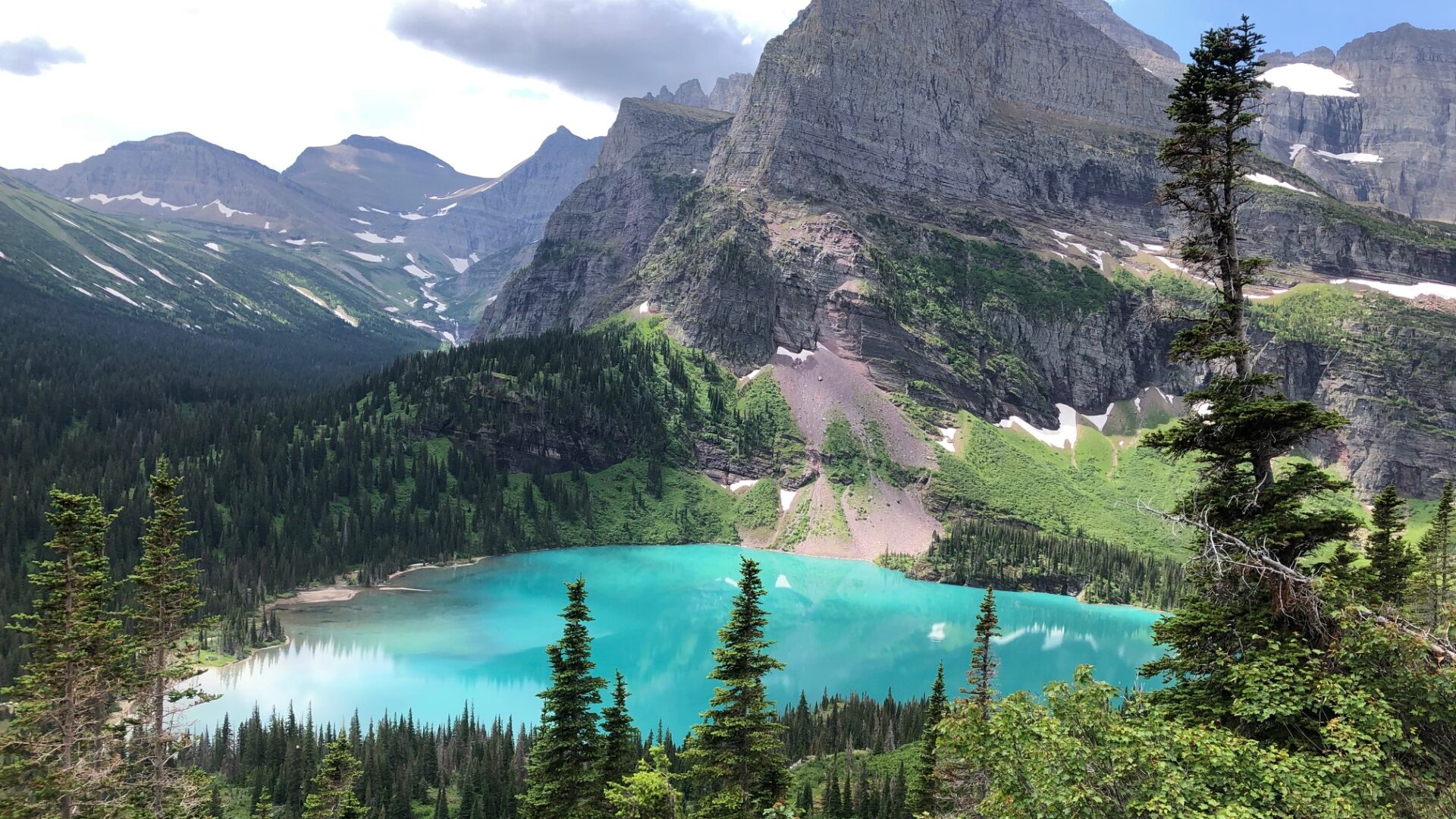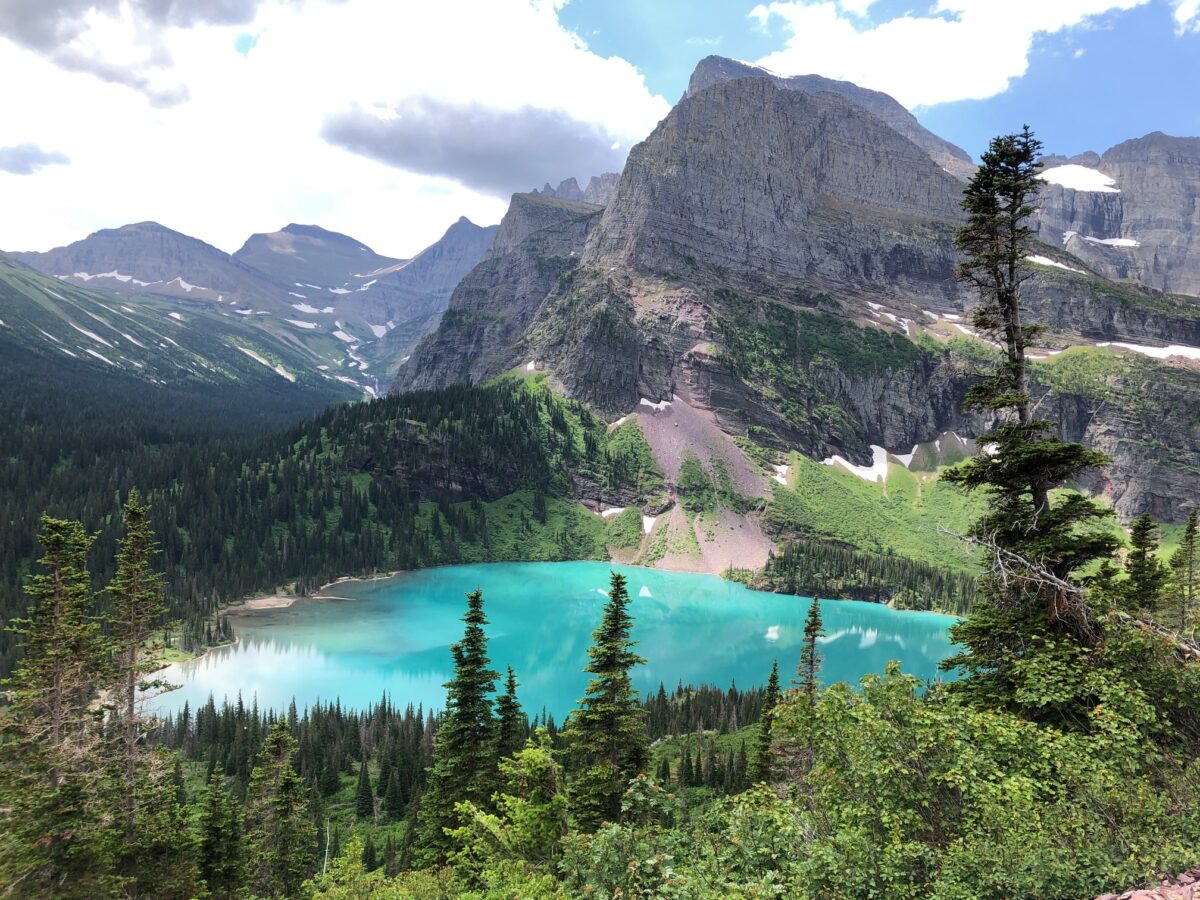Glacier National Park: Losing a Namesake
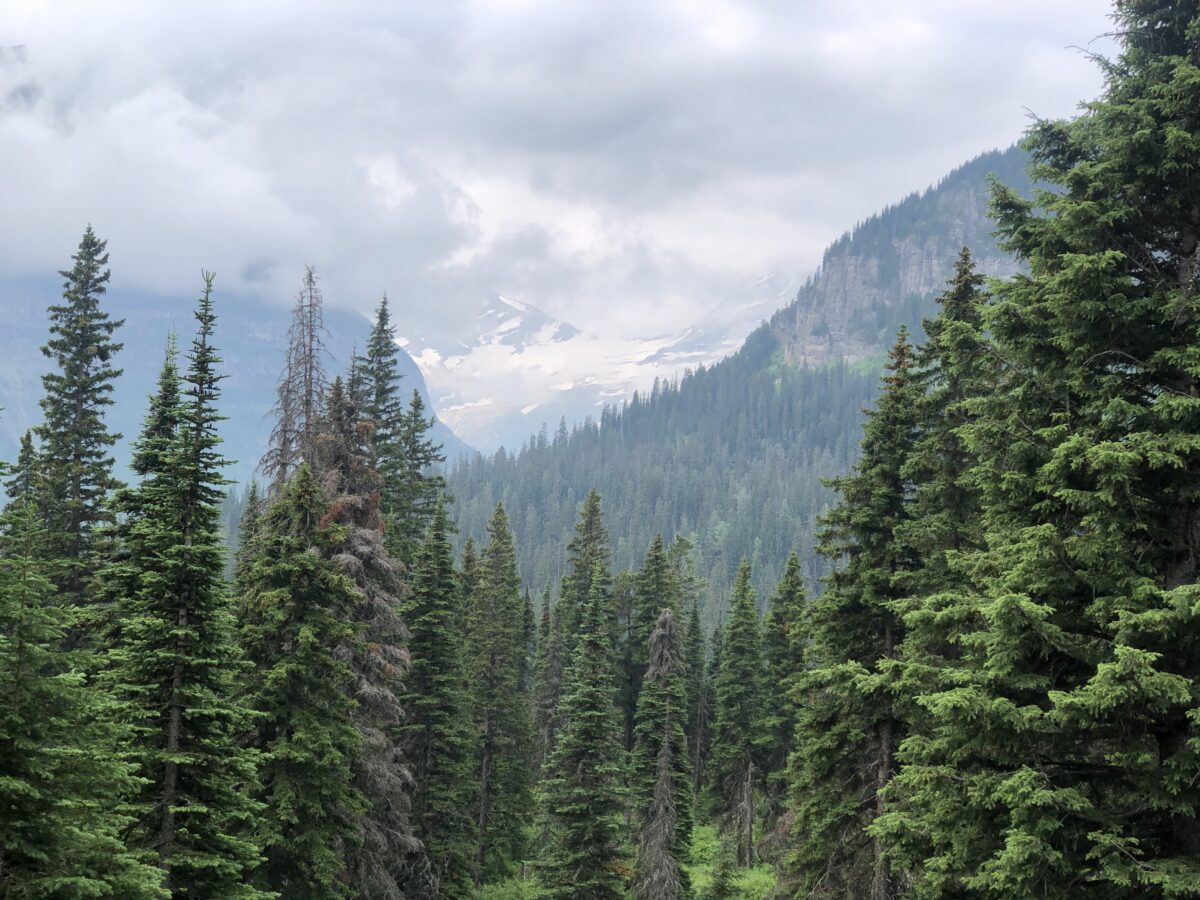
When Glacier National Park was established in 1910, there were over 100 glaciers. By 1966, there were only 35 named glaciers. By 2015, only 26 met the criteria of being active glaciers. And by 2030, it is predicted that there will be no glaciers remaining, just snow fields.
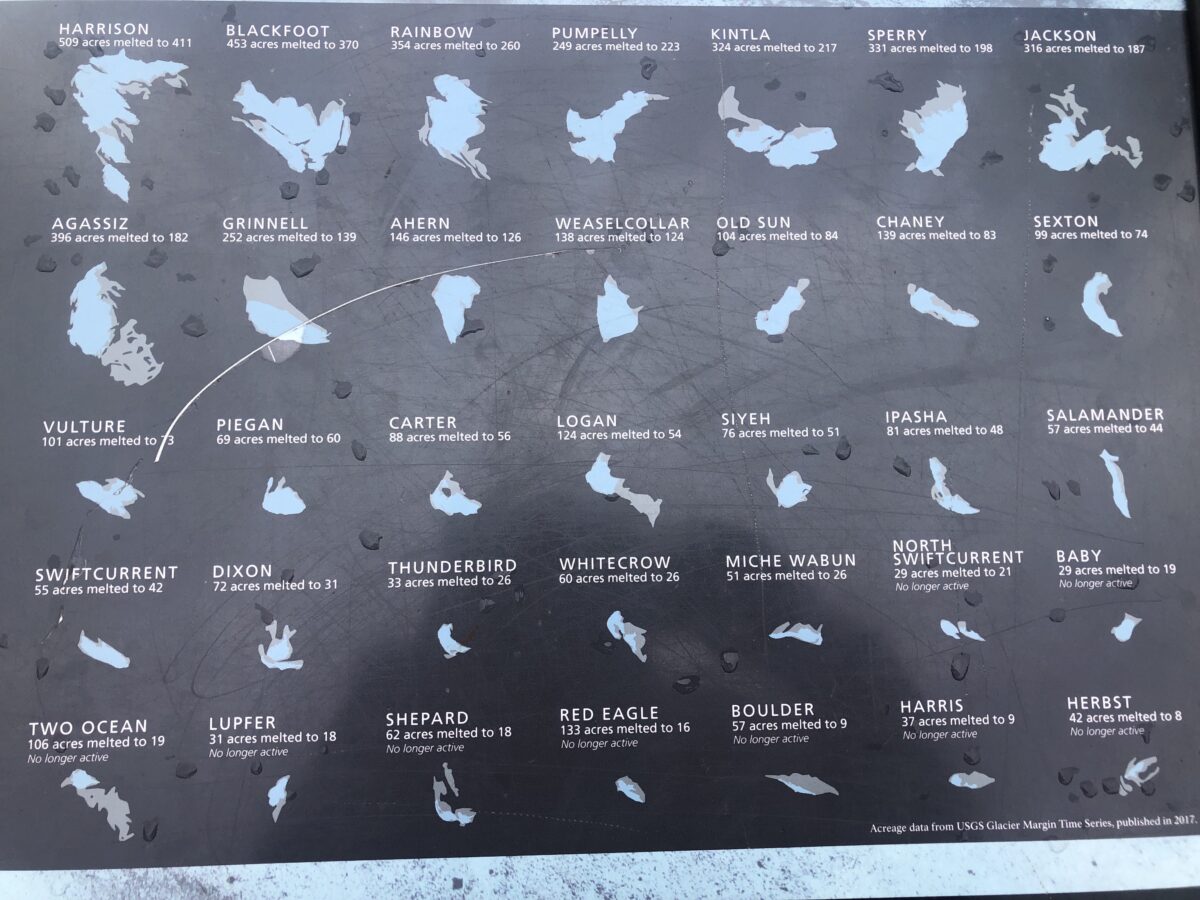
Fortunately Glacier National Park is not just about glaciers. Encompassing about 1 million acres, this national park has much more to offer – amazing scenery and a wide array of wildlife, plus human history, old chalets and lodges. There are over 700 miles of trails, from accessible nature trails to multi-day backcountry hikes. In fact, Glacier National Park really has something for everyone!
The hardest decision is what part of the park to visit.
West Glacier
Most people arrive at Glacier National Park via the west entrance, coming from Kalispell, Montana. There are lots of services here and fun things for families to do. Along with all sorts of camping and lodging options outside of the park, there are a number of campgrounds and lodging options inside the park. Note that most require advance reservations.
We camped at Fish Creek, right on the edge of Lake McDonald. There are several hikes from there and it is also a great place for watersports. We had a blast with our paddle boards. (But, be careful. You MUST have all watercraft, even floaties, officially checked and tagged before you can put them in the water. Please help control the spread of zebra mussels and comply. Having the proper permit also avoids getting a citation.)
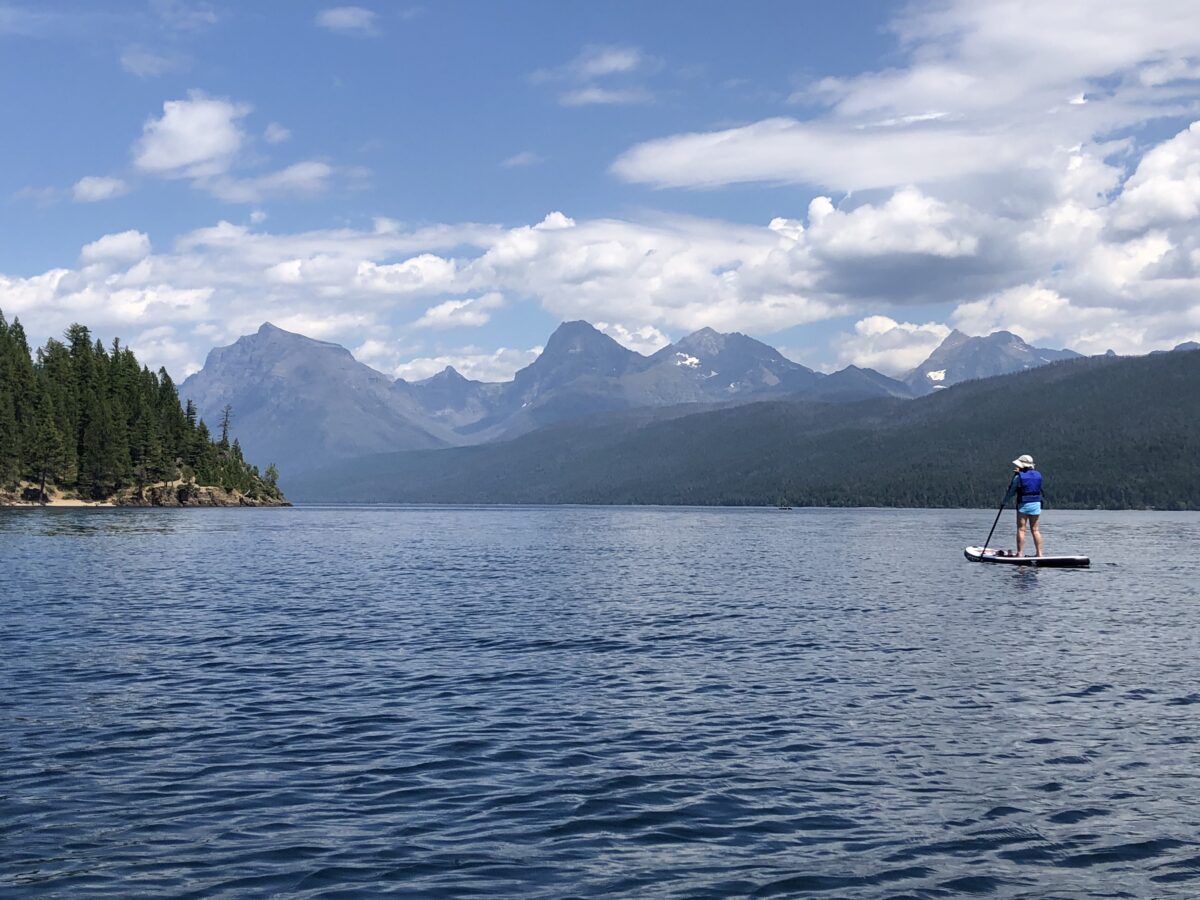
Going to the Sun Road
West Glacier is the main jumping off point for the famous Going to the Sun Road. During summer months you must have a pass to drive on this historical road, and there are serious height and length restrictions. This road is spectacular, but not for the faint-hearted. It is very narrow with lots of hairpin curves, and in some places you are looking straight down.
We would highly recommend the shuttle. Make it easy on yourself. Take an express shuttle up to Logan Pass (check for times) and let the driver negotiate the turns. Then all you need to do is take in the view and watch out for wildlife. At Logan Pass go to the visitor center, look for bighorn sheep and mountain goats, do some hikes and then take the bus back down, optionally stopping at any or all of the shuttle bus stops.
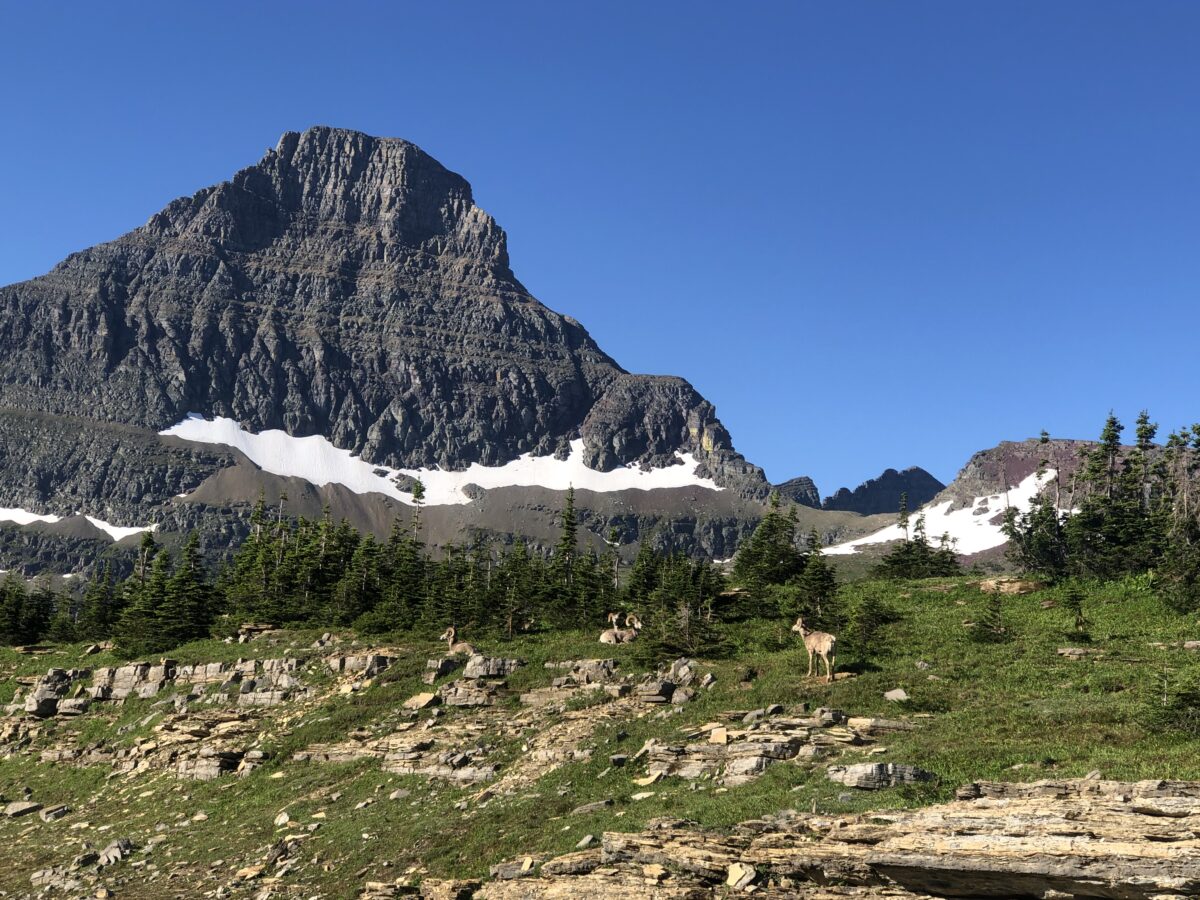
Hikes
From Logan Pass, you can take the Hidden Lake Nature Trail or embark on other more strenuous hikes, including one of the most popular hikes in the park – the Highline Trail. Take this out and back, or hike this to The Loop Trailhead where you can pick up the shuttle again.
Another shuttle stop takes you to the popular Avalanche Lake trail. There is a parking lot there, but beware, it fills up early. That’s another great reason to take the shuttle. Parking everywhere along the Going to the Sun road is at a premium.
Lake McDonald Lodge
One of the shuttle stops is at Lake McDonald Lodge. Built in 1912, this is one of several “Swiss chalet” style lodges in Glacier National Park. Nestled on the lake shore, this historic lodge has 82 guest rooms plus a restaurant and lounge. There is a scenic tour boat and boat rentals. Try out a paddle board or take a kayak out for a spin on the fairly flat water.
East Glacier
Another great lodge is at East Glacier, located across the street from the AMTRAK station. Historically, park visitors came by train and folks still arrive this way today. Built between 1912 and 1914, the East Glacier Lodge is simply spectacular. It has a huge lobby, with pillars made from giant trees. This was the first hotel built by the Great Northern Railway. Today it offers 161 guest rooms and a golf course! Even if you don’t stay there, it is worth stopping by.
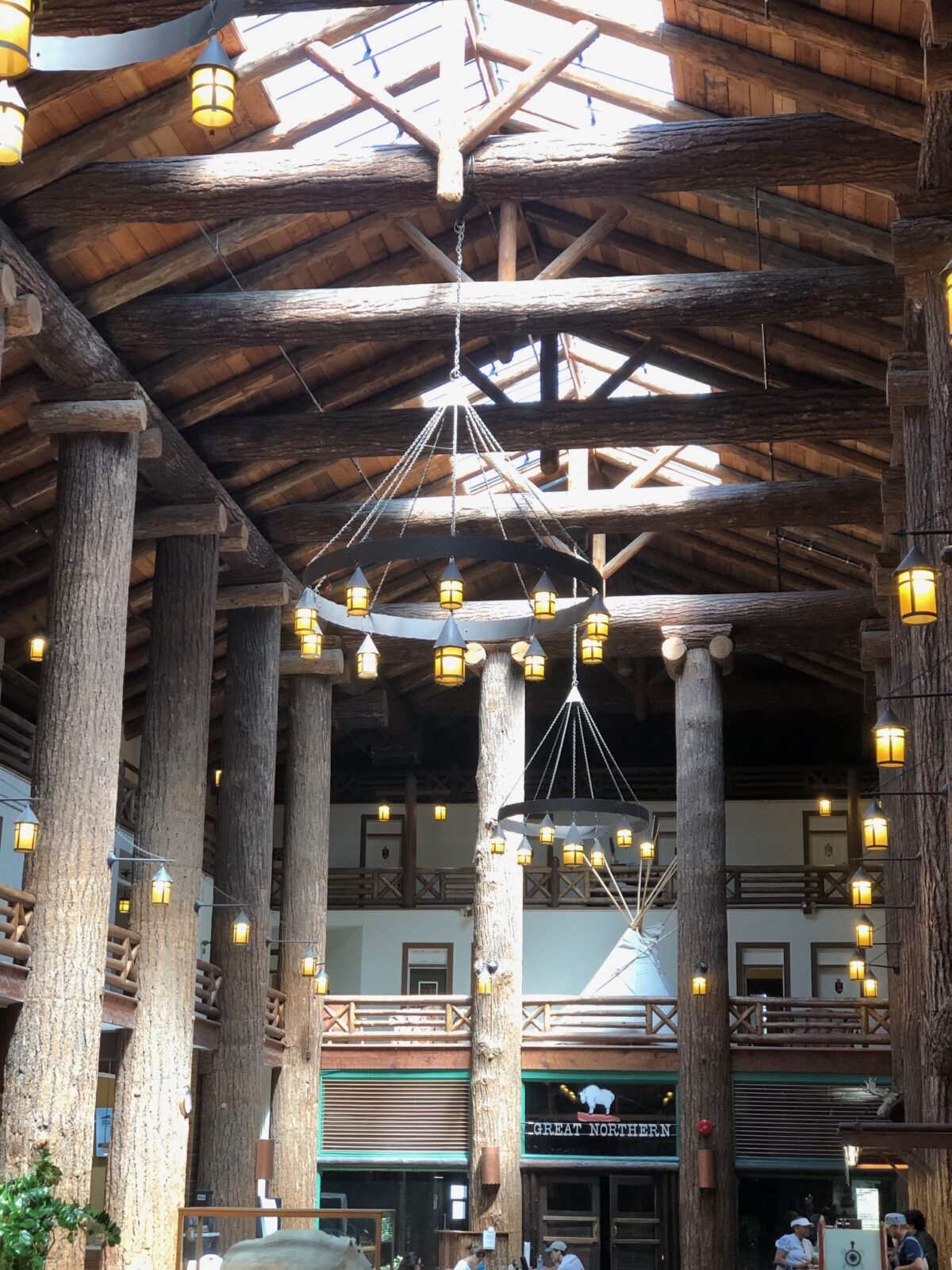
East Glacier Lodge is not actually within Glacier National Park, but they do offer a free shuttle into Two Medicine, taking you right to the boat dock.
Two Medicine
We loved Two Medicine. It is one of the least crowded areas of Glacier National Park and has lots to offer. We camped there and saw bear, moose, elk and bighorn sheep right from the campground.
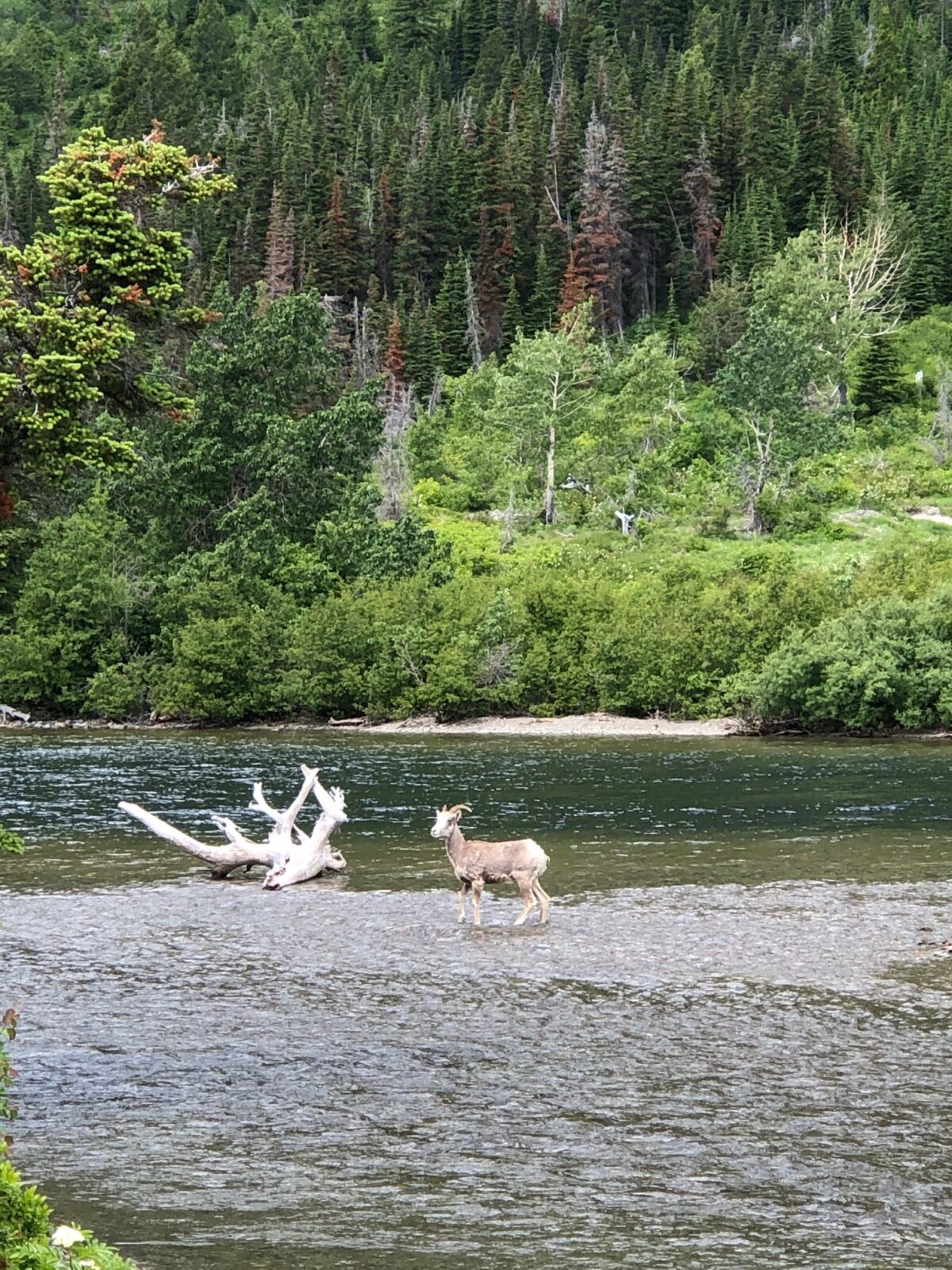
There were tons of hikes of all levels of difficulty. The big hike from Two Medicine is Pitamakan Pass, an 18.8 mile loop that takes you up over 6,000 feet in elevation. It is hard and long, but the views are amazing.
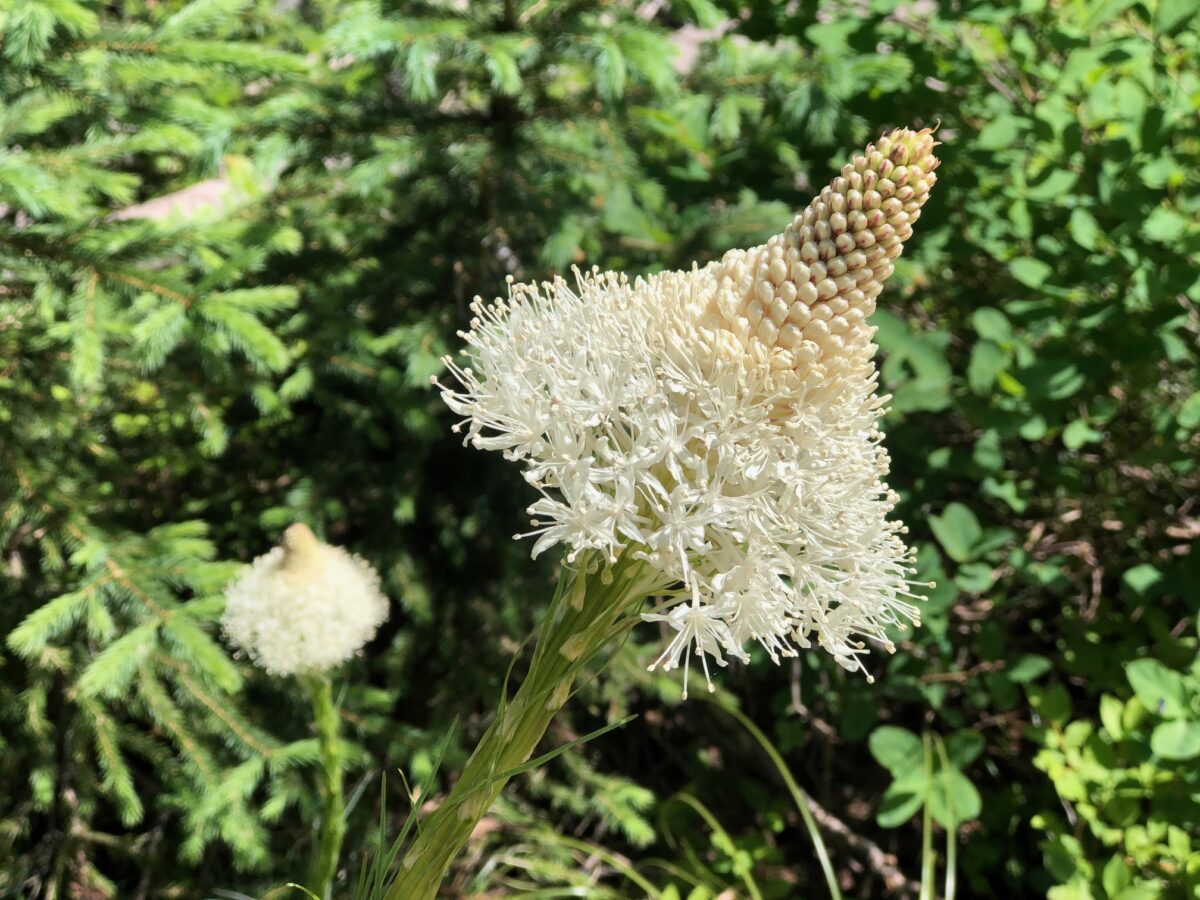
Many of the hikes take you to lovely waterfalls. One of the most unique waterfalls was Running Eagle Falls, pouring out of the rock face. Be sure to stop on the way in or out of Two Medicine, and take the short walk to check out these falls. On any hike, be sure to take bear spray and be “bear aware”. You never know when one might pop out on to the trail and you don’t want to surprise them.
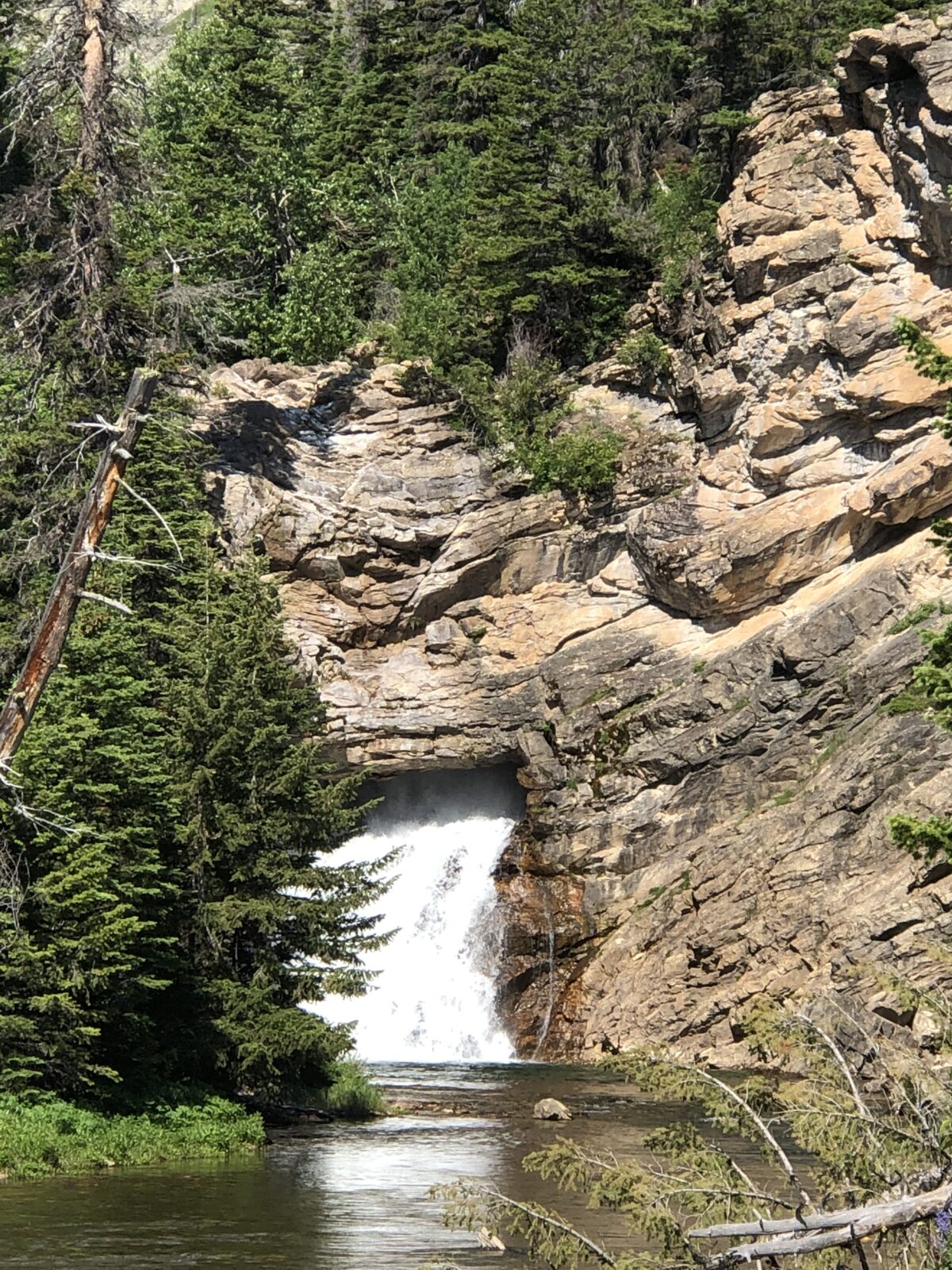
One of the highlights of Glacier National Park are the boat rides on the lakes – two way scenic cruises or one-way shuttles to or from hiking trails. The boat across Two Medicine Lake takes you to a trailhead where you can take the short, flat walk up to Upper Two Medicine Lake, stopping at Twin Falls on your way. If you like to fish, take your tackle. Most lakes allow fishing and you don’t need a fishing license. It is quite likely you will be the only person fishing on the lake!
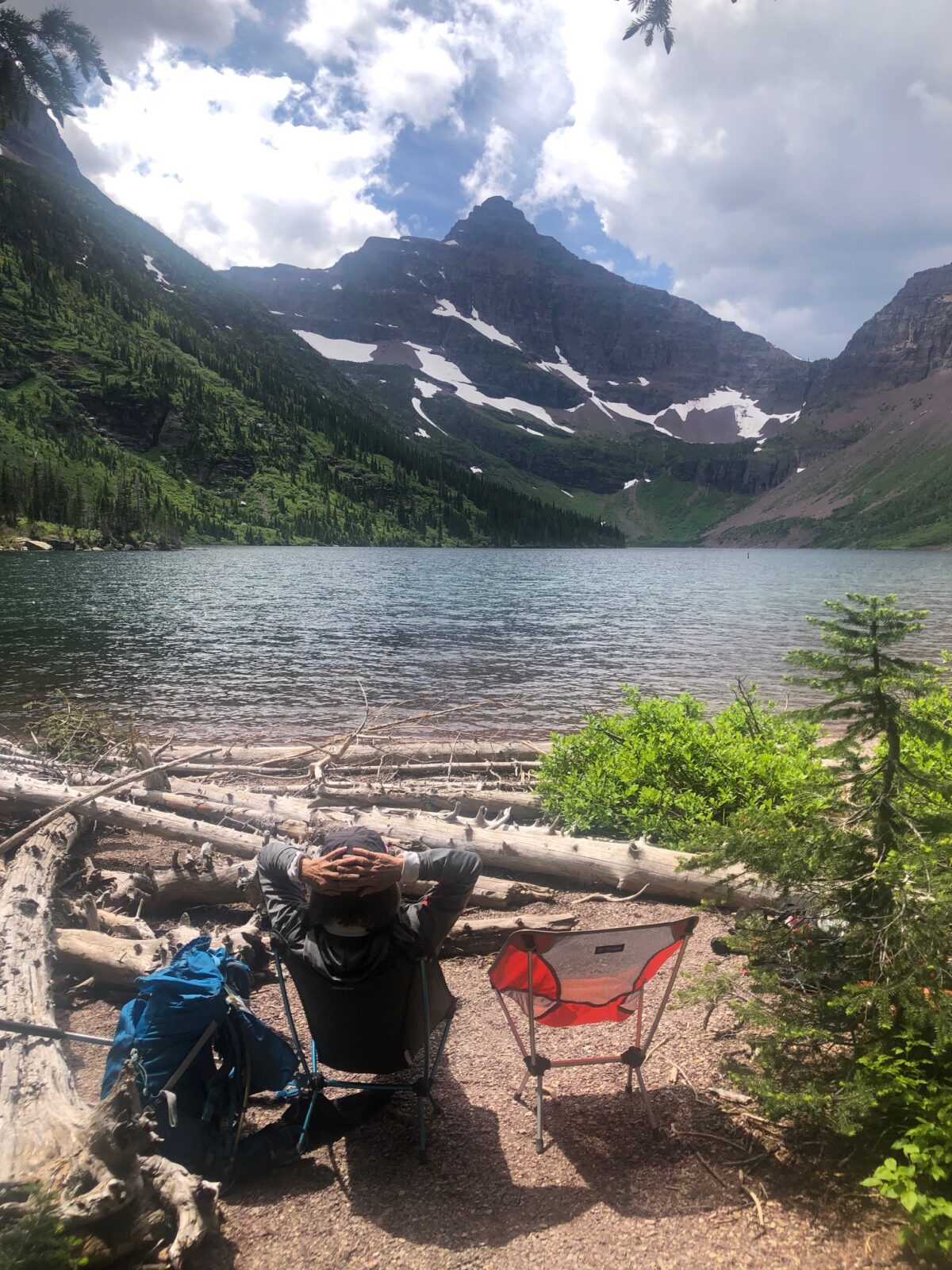
St. Mary
Thirty eight miles north of East Glacier is St Mary – midway between Two Medicine and Many Glacier – providing access to both. This is also a good alternative if you want to do the Going to the Sun Road. If you secure a pass to drive, it isn’t quite as hair-raising up to Logan Pass from the east side. But we still recommend taking the shuttle. There is an express to Logan Pass (check the schedule) and from there you can change busses to take the road west as far as you like, and then come back. It would be a full day but you’d get to see everything!
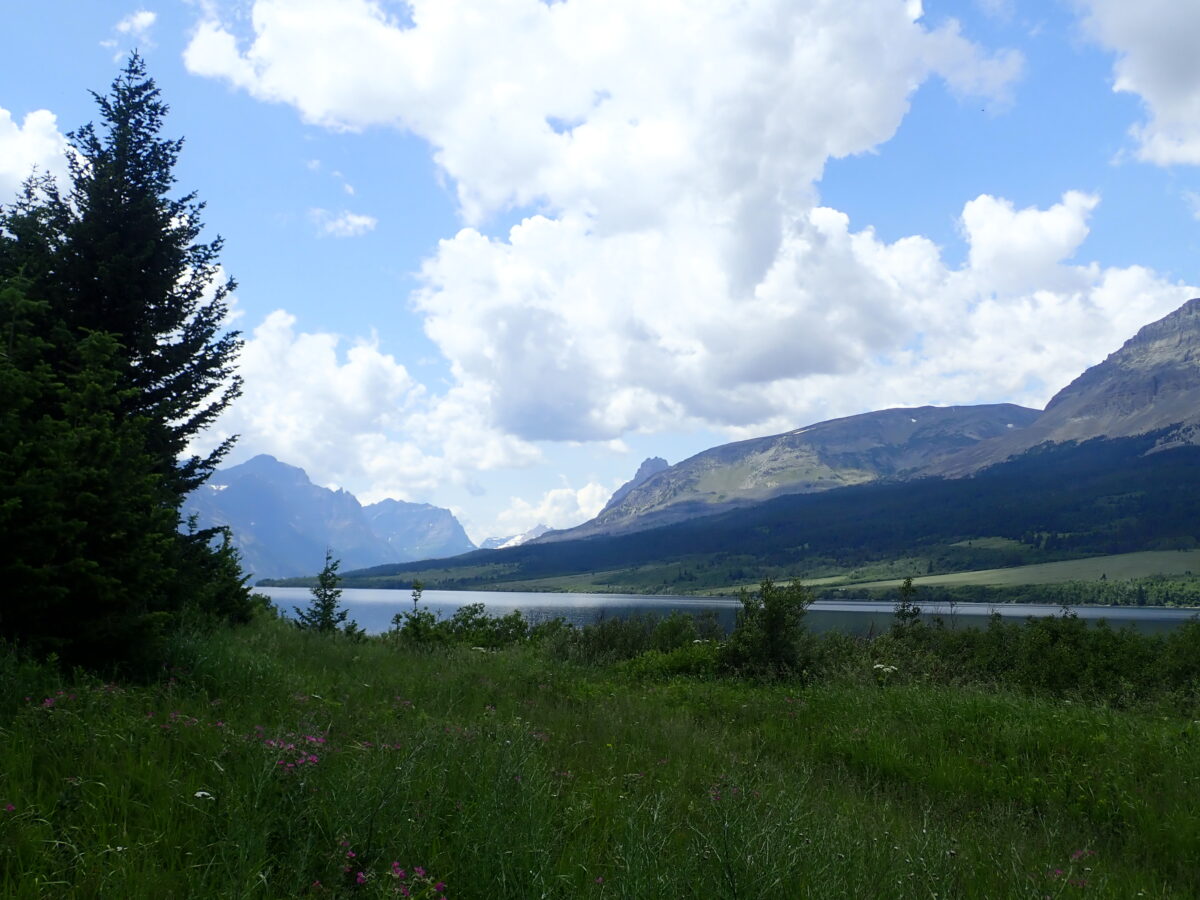
St. Mary offers lots of services – restaurants, lodging, visitor center and a big campground with cell service! (Most of the park does not have any service.) There is also a really good grocery store if you need to restock. If you like to hike, there are also a few nice hikes. St. Mary Falls, Baring Falls and the Beaver Pond Trail. That one is a short 3.3 mile loop that starts from the 1913 Ranger Station.
Many Glacier
North of St. Mary is Many Glacier, but beware, once you enter the park there is a portion of the road that is not paved. (It is okay for RVs but bumpy.) Many Glacier is probably the most difficult place to get a campground or hotel reservation, but well worth the effort. The valley is simple gorgeous.
Many Glacier Lodge, another Swiss-chalet style lodge, was built in 1915. This is the largest of the Glacier National Park lodges and offers 214 rooms. It sits on the shore of Swiftcurrent Lake and looks up at the imposing cliffs of Mount Grinnell.
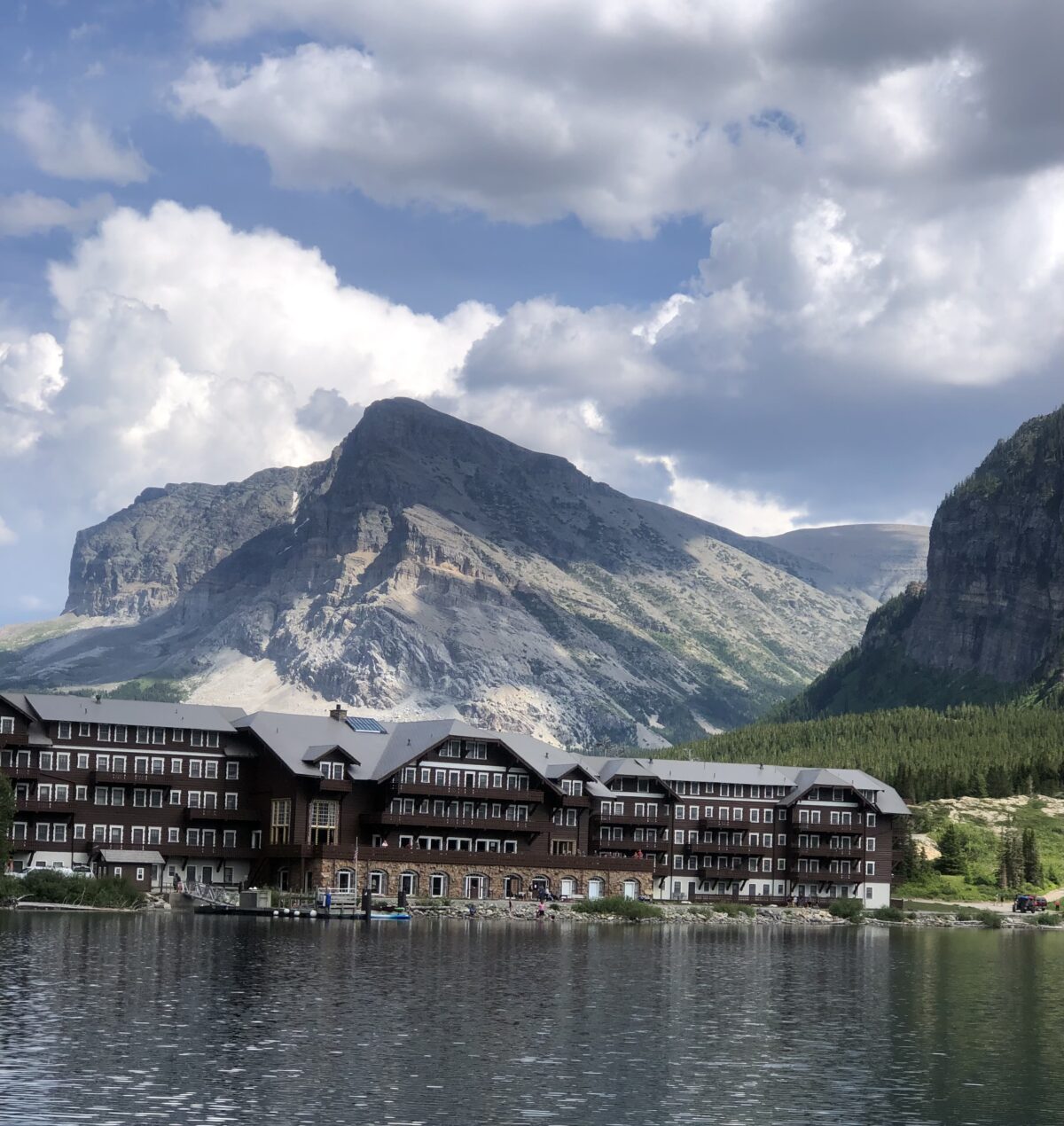
This lake is beautiful. It is shallow (only 16 feet deep), so it is nice for paddling, fishing and even swimming. We enjoyed listening the Loons and seeing the Mergansers with their new families.
Boat Cruise
We would also highly recommend the scenic boat cruise here.
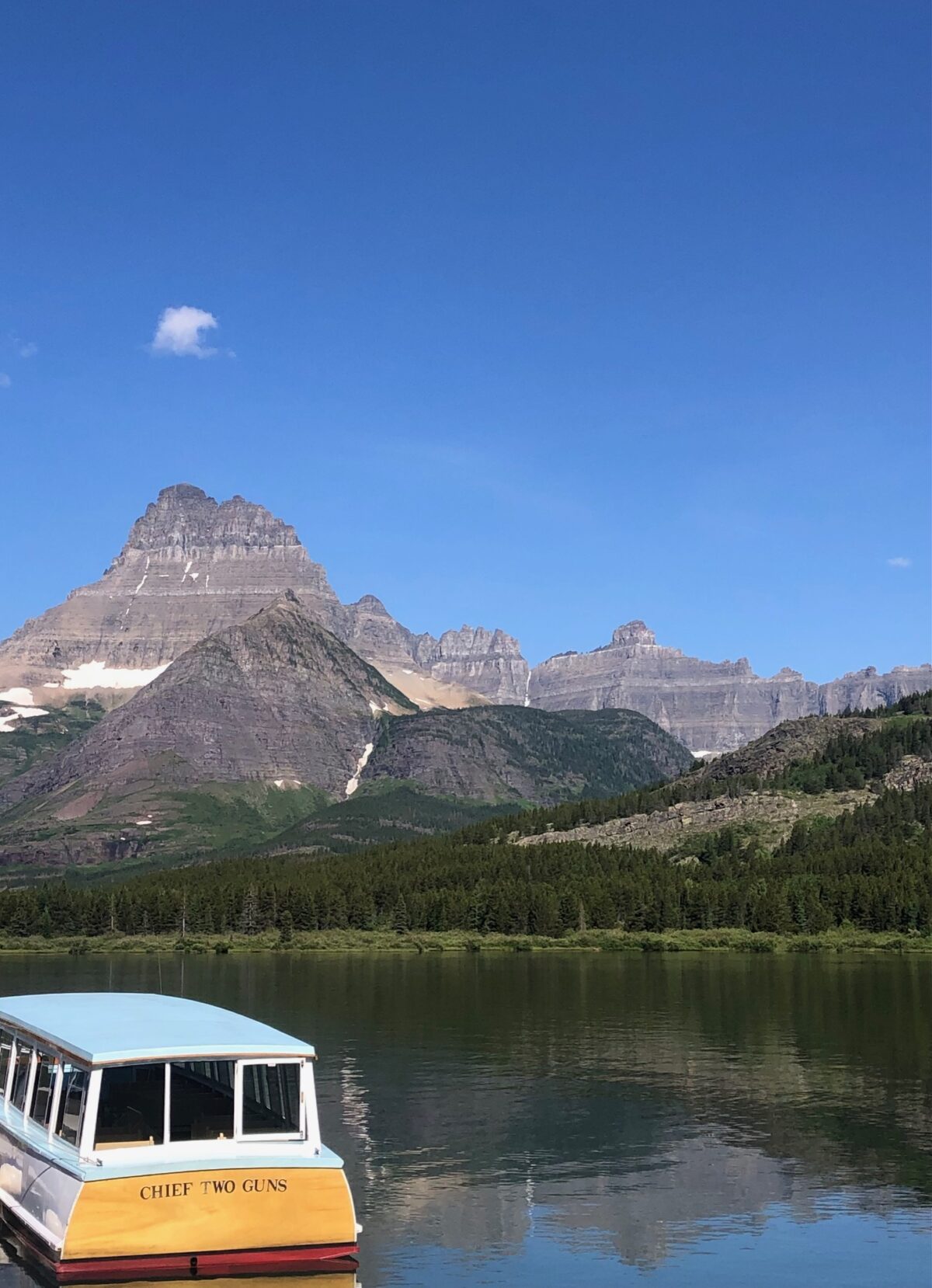
The first boat goes from Many Glacier Lodge to the end of Swiftcurrent Lake, where you disembark and walk a quarter mile to another boat dock on Lake Josephine. From there another boat takes you to the end of this lake from where you can walk to Grinnell Lake (a flat 2.8 miles round trip) or you can take a strenuous hike to the Grinnell Lake overlook (and if it is open, continue to the Grinnell Glacier Viewpoint. 7.2 miles round trip from the boat dock.) Although difficult, the views from this overlook are stunning.
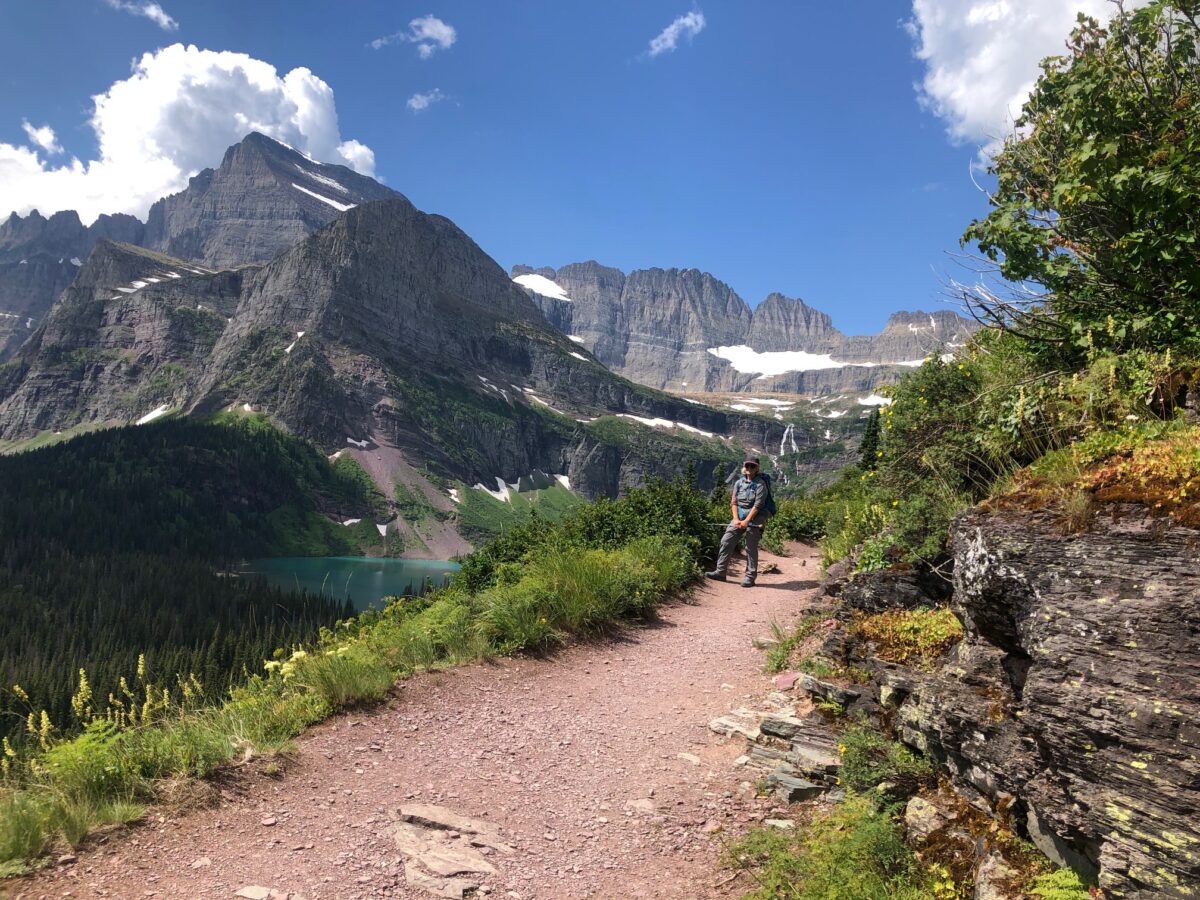
We also really enjoyed all the fun facts that the boat drivers shared about the history of the lodge, scenery and wildlife.
Hikes
You can spend days hiking in the Many Glacier area, from easy hikes around Swiftcurrent and Josephine Lakes to much longer and more strenuous hikes like the 15.3 mile hike to the Ptarmigan Tunnel. In fact, there are over 100 miles of hiking trails in the Many Glacier area however you always need to check with the range to see what trails are open. Some may be closed due to bear activity. Rangers keep a pretty close eye on this.
Wildlife
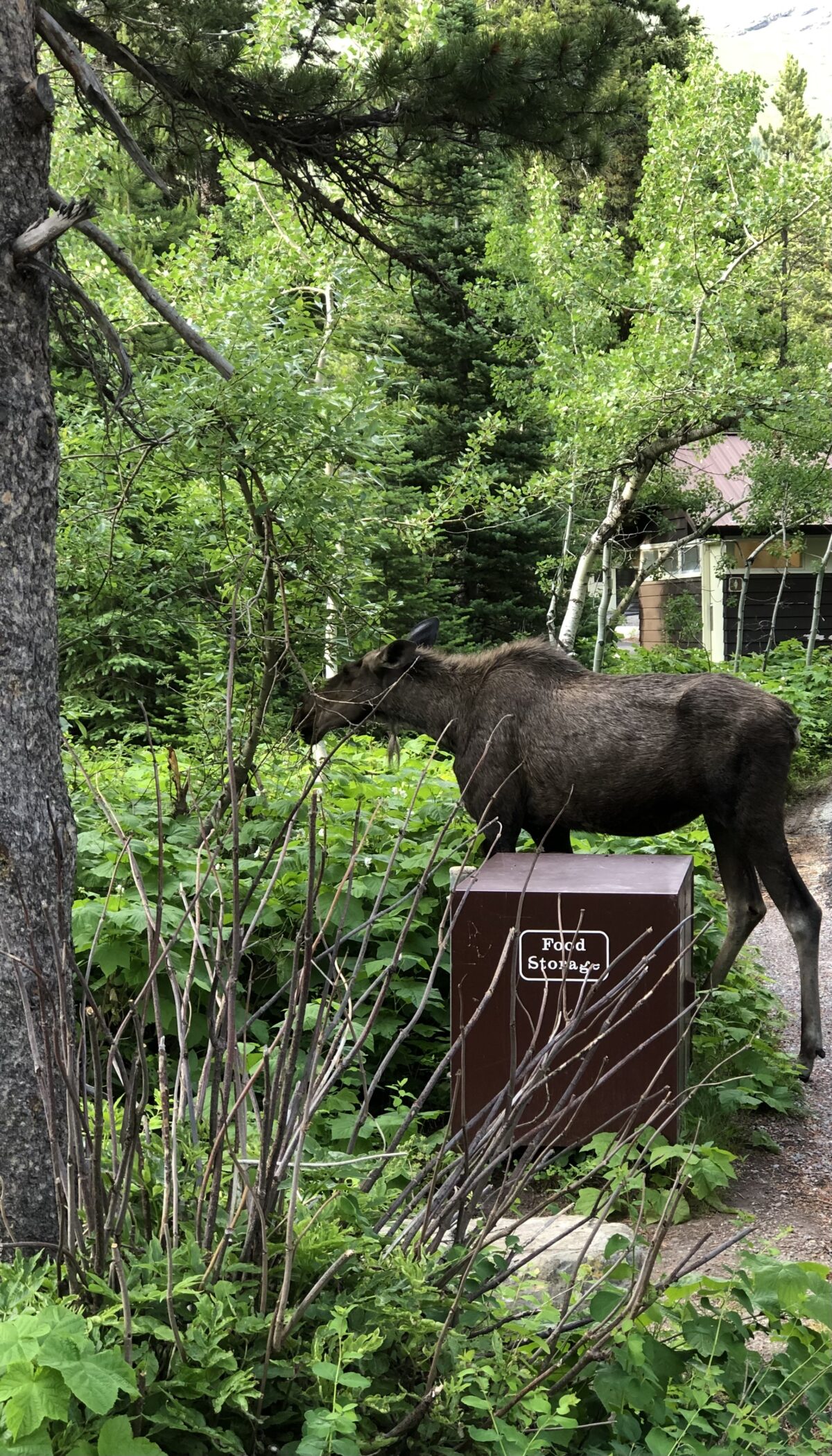
You are pretty sure to see wildlife when you are out hiking in the Many Glacier area, and probably even in the campground. But if you don’t, each night a ranger is out in the parking lot at Swiftcurrent Motor Inn (right beside the campground) with a scope. When we were there, she spied a bear and her cub, and a herd of mountain goats with kids.

Waterton-Glacier International Peace Park
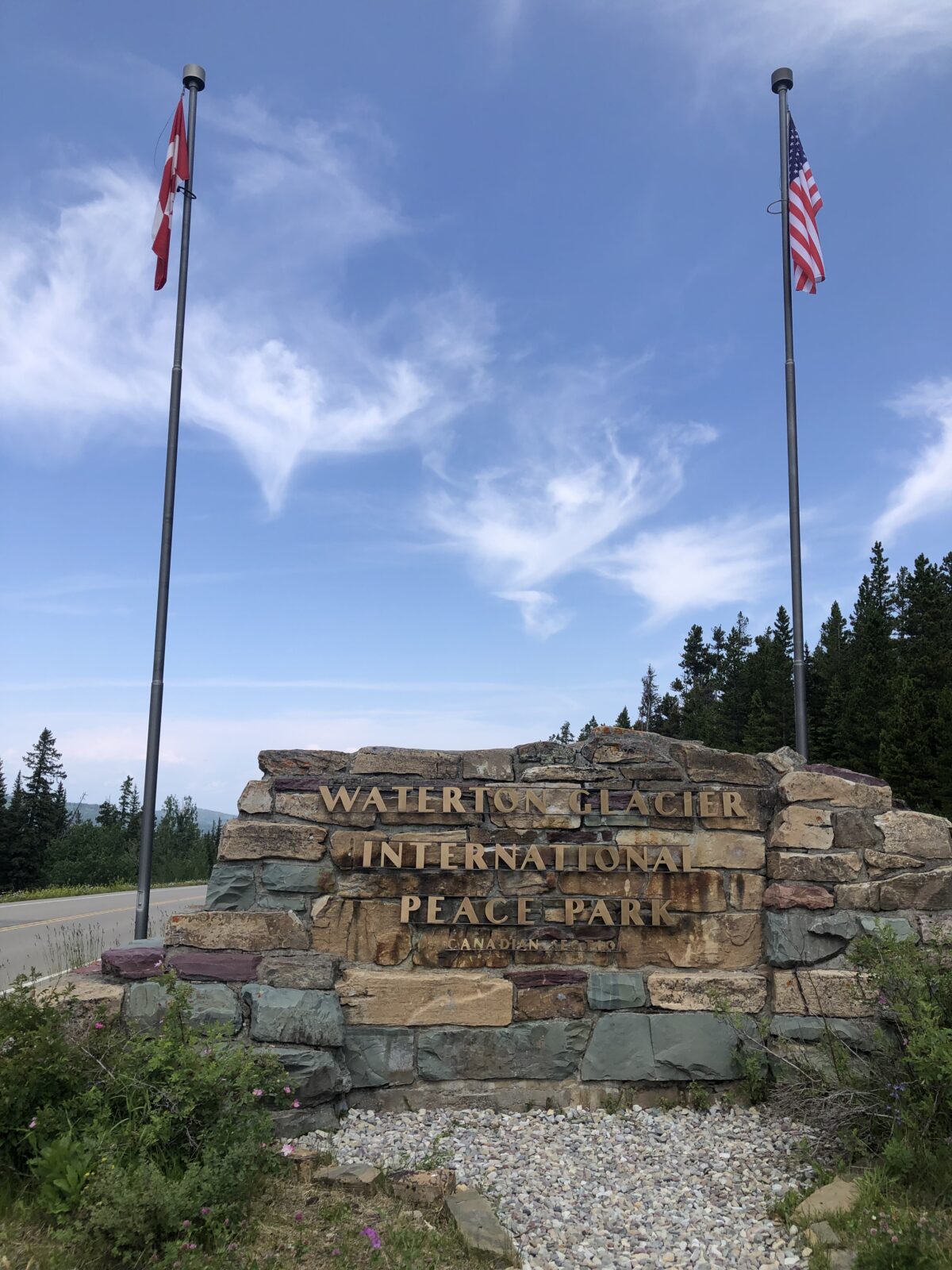
Keep going north into Canada to visit more of the park. Unique to Glacier National Park is the partnership that it has with Waterton Lakes National Park in Canada. Recognizing that animals and nature have no boundaries, the two countries created the world’s first International Peace Park in 1932. Both countries continue to work together in harmony to manage this unique environment and the natural beauty that the parks offer. In fact, Canadian rangers regularly present at ranger talks in the US and rangers from the US regularly go to Canada to talk about Glacier National Park.
With a tag line of “where the prairies meet the peaks”, Waterton Lakes National Park includes both rugged mountains as well as prairies in its 195 square miles. It was named the fourth national park in Canada in 1895.
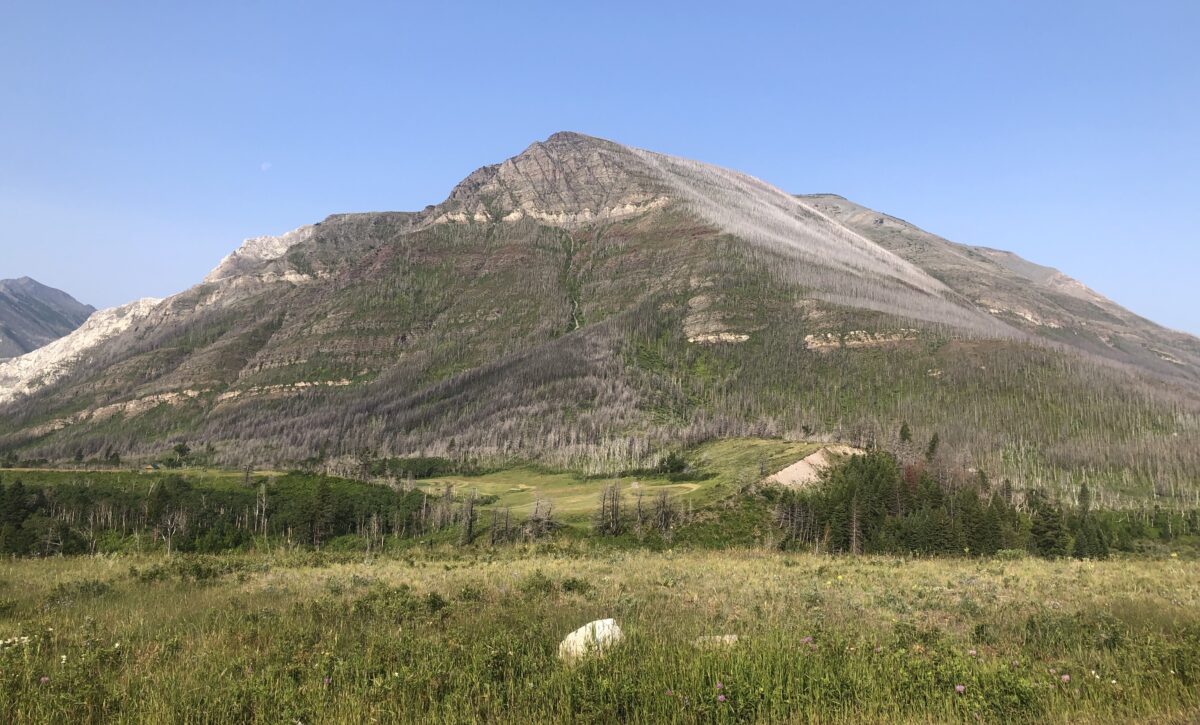
The park offers a much different experience than Glacier. First of all, almost 40% of the park burnt in the 2017 lightning caused wildfire. So rather than hills covered with gorgeous green trees, you see the skeletons of burned trees surrounded by fresh shrubs and new growth, plus tons of wildflowers. It is great to see how the burned areas regenerate.
Waterton Townsite
Your visit will center around Waterton Townsite, first settled in 1902 after an oil strike in the Cameron Valley. In 1910, the town was surveyed to include 150 lots, plus hotels and other businesses. In 1927, the stately Prince of Wales hotel (still operational today) was built overlooking the town. And by 1931, this place was a thriving town with a school, churches, restaurants, shops and lodgings. That’s what you will still find today when you visit.
We stayed in the campground, right at the edge of town and right along the lake. It is large, but offers nice services and is just a short walk from all the amenities of town. If you like water sports, this is the place to be. Perfect for a morning paddle before the wind comes up.
Scenic Drives
There are two scenic drives: Red Rock Parkway and Akamina Parkway, both less than 20 miles round trip from town. You will likely encounter wildlife. We certainly did.
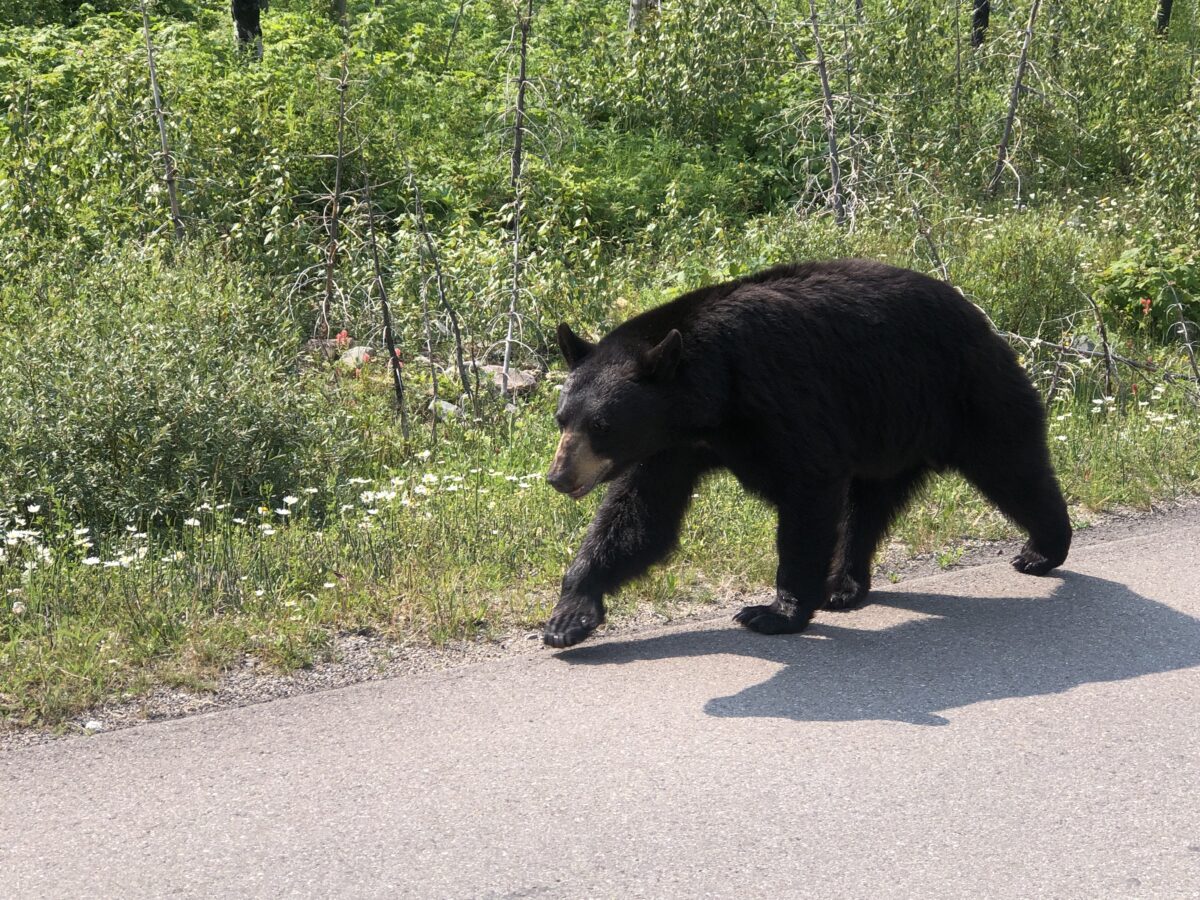
Red Rock Parkway ends at Red Rock Canyon where you can enjoy a short nature trail (partially paved) or embark on a longer hike into the backcountry.
Along the Akamina Parkway you will see the site of the first oil well and can read the history. The road ends at glacier-fed Cameron Lake. It is gorgeous! Take (or rent) a paddle board or kayak, and paddle the 2 miles to the end of the lake to see the hanging garden and waterfall. Touch the shore and you’ll be touching Montana!
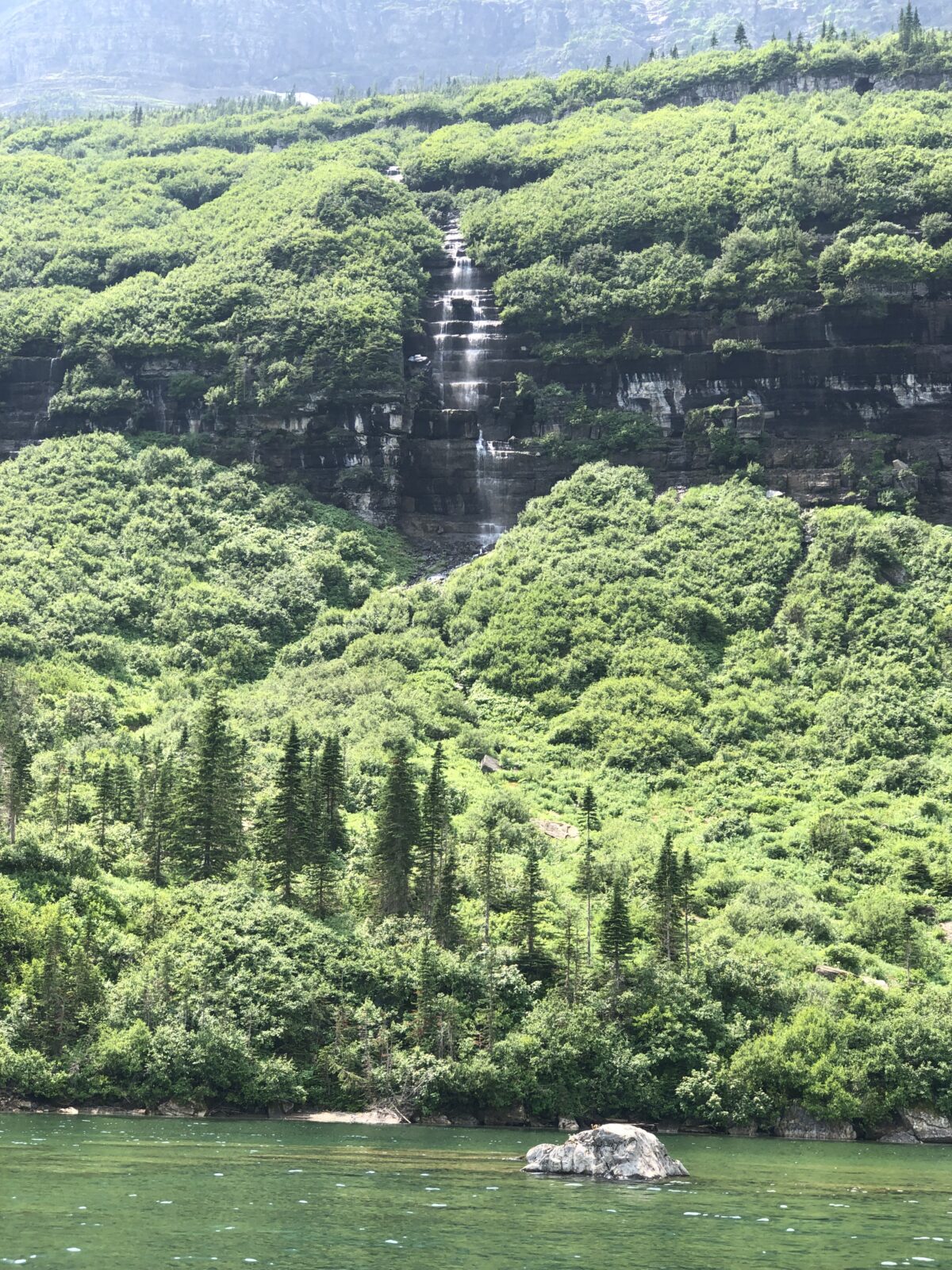
Along both routes there are overlooks and trailheads for hikes of various distances. There are also a couple of hikes right from the townsite. In all, there are over 120 miles of hiking trails in Waterton, many that hook up with hikes in Glacier. Just be sure to take a passport and follow the instructions for passing border control.
Boat Cruise
One of the hikes, Crypt Lake, can only be reached by taking a shuttle across the lake. They take you early in the day and come back to pick you up in the afternoon. This has been named by National Geographic as one of the world’s top 20 hikes, but beware. It has also been called one of the most thrilling, and includes ladders, tunnels and clinging to a chains! Not for the weak of heart.
Other trails are also accessible by boat. The Waterton Lake Scenic Cruise takes you across Upper Waterton Lake. It is 7 miles long and the deepest lake in the Rockies – 435 feet deep. The cruise ends at Goat Haunt Ranger Station in Montana. On the way, the boat stops at the border so that you can see how it is clearly delineated with a wide strip where all the trees have been cut.
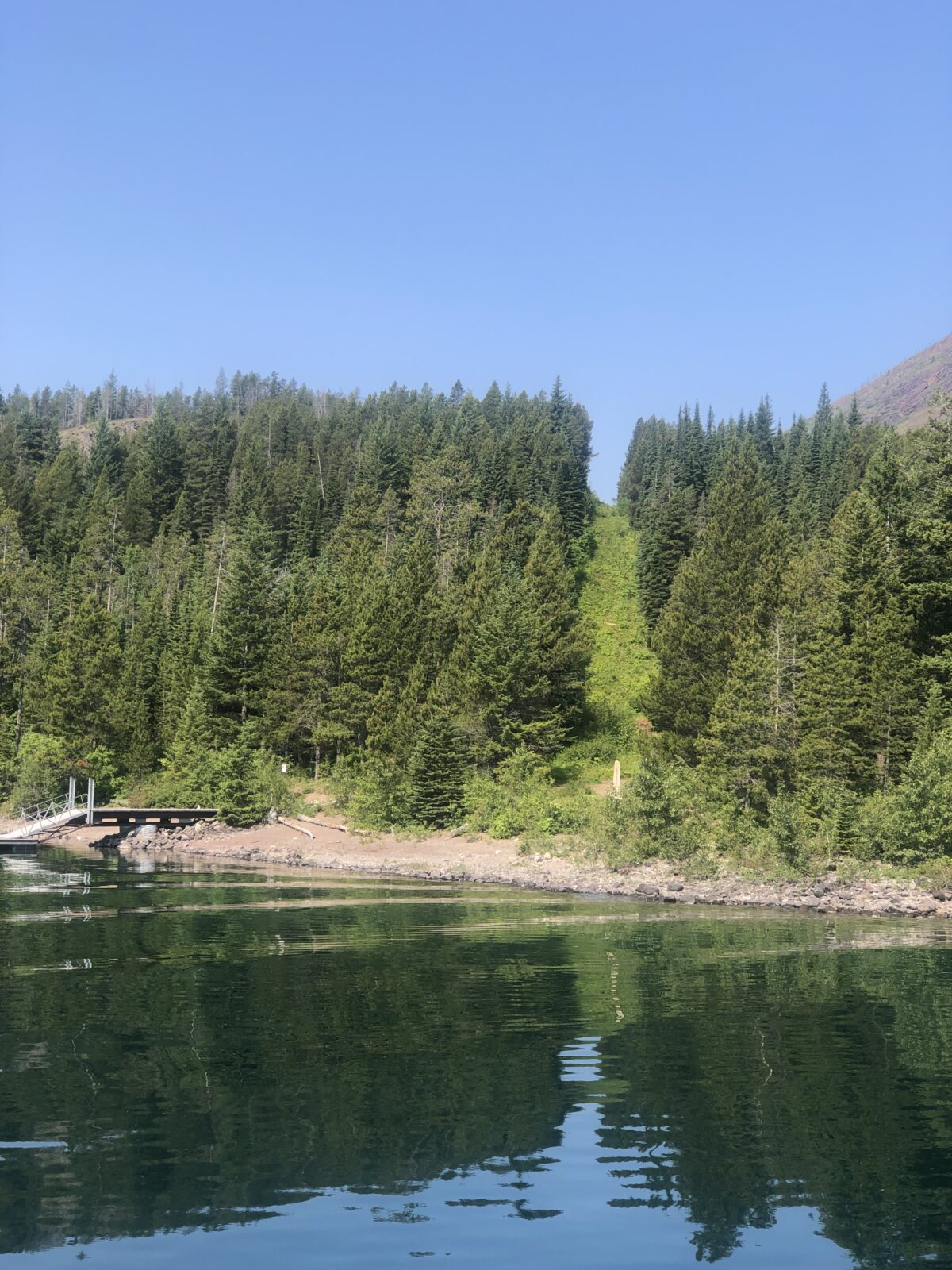
They also point out Mount Cleveland. It straddles Waterton and Glacier National Parks, and is the tallest in either at 10,466 feet. This is a lovely boat ride, even if you aren’t hiking, providing a good introduction to both parks.
Goat Haunt
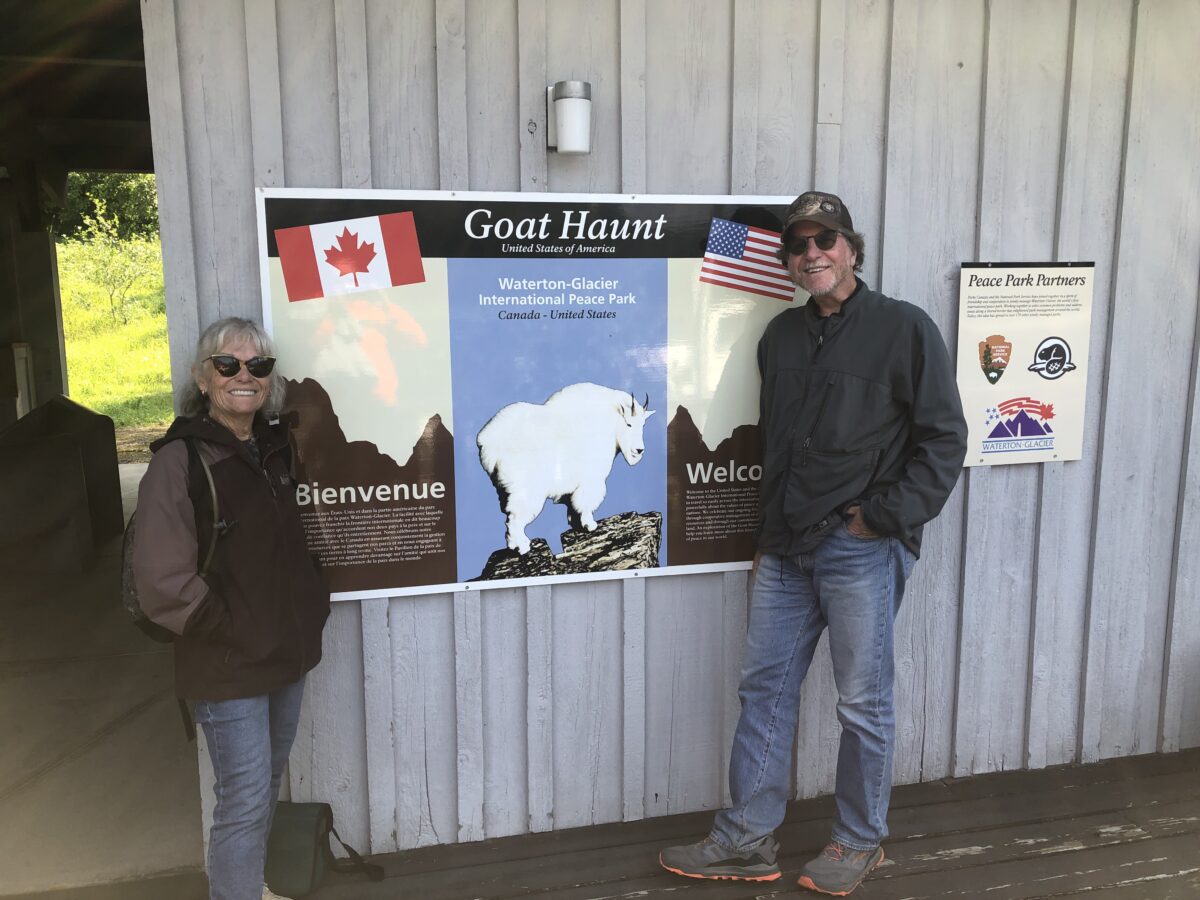
Goat Haunt is the start or end for multi-day wilderness hikes into Glacier National Park. Hikers to Goat Haunt can arrange to be picked up by the boat and then get a shuttle back to their car in the US. From Goat Haunt, there is also a short ranger-led hike from there to a waterfall. Note that any hiking requires a passport. (See website for details.)
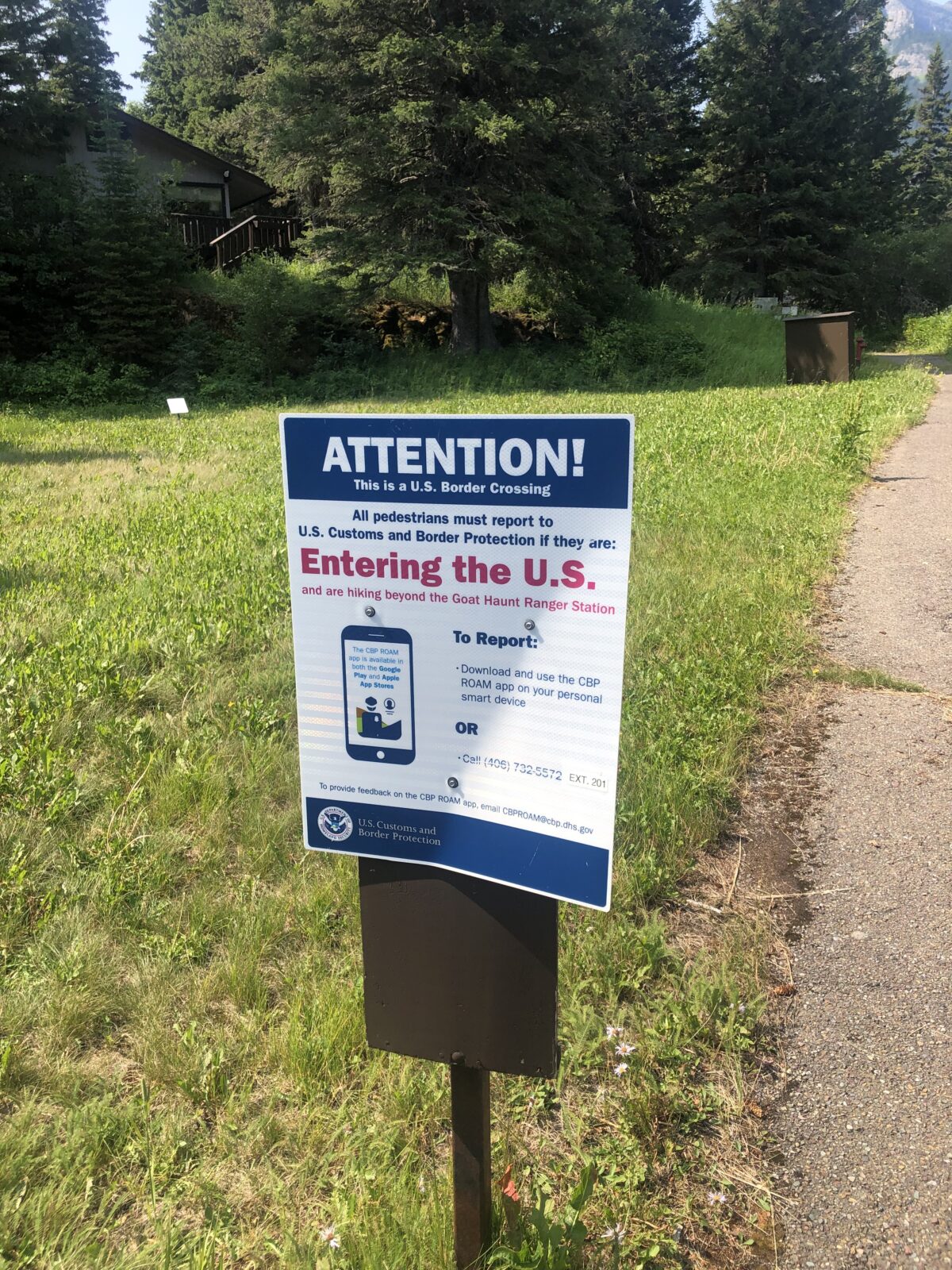
Another interesting option is a “Hike Across Countries” – hiking about 9 miles from Waterton Townsite in Canada along the lake to the ranger station in the US, where you can pick up the boat to return. There is an option to do this as a ranger-led hike. That would be interesting, but at the time of this writing, this hike only goes on Fridays so we missed it.
Fishing
Note about fishing… Glacier National Park does not require a fishing license. Waterton Lakes National Park does. The compromise on Waterton Lake – if you fish from land on the US end of the lake, no license is required. If you fish anywhere on the lake from a boat, you need an Alberta fishing license.
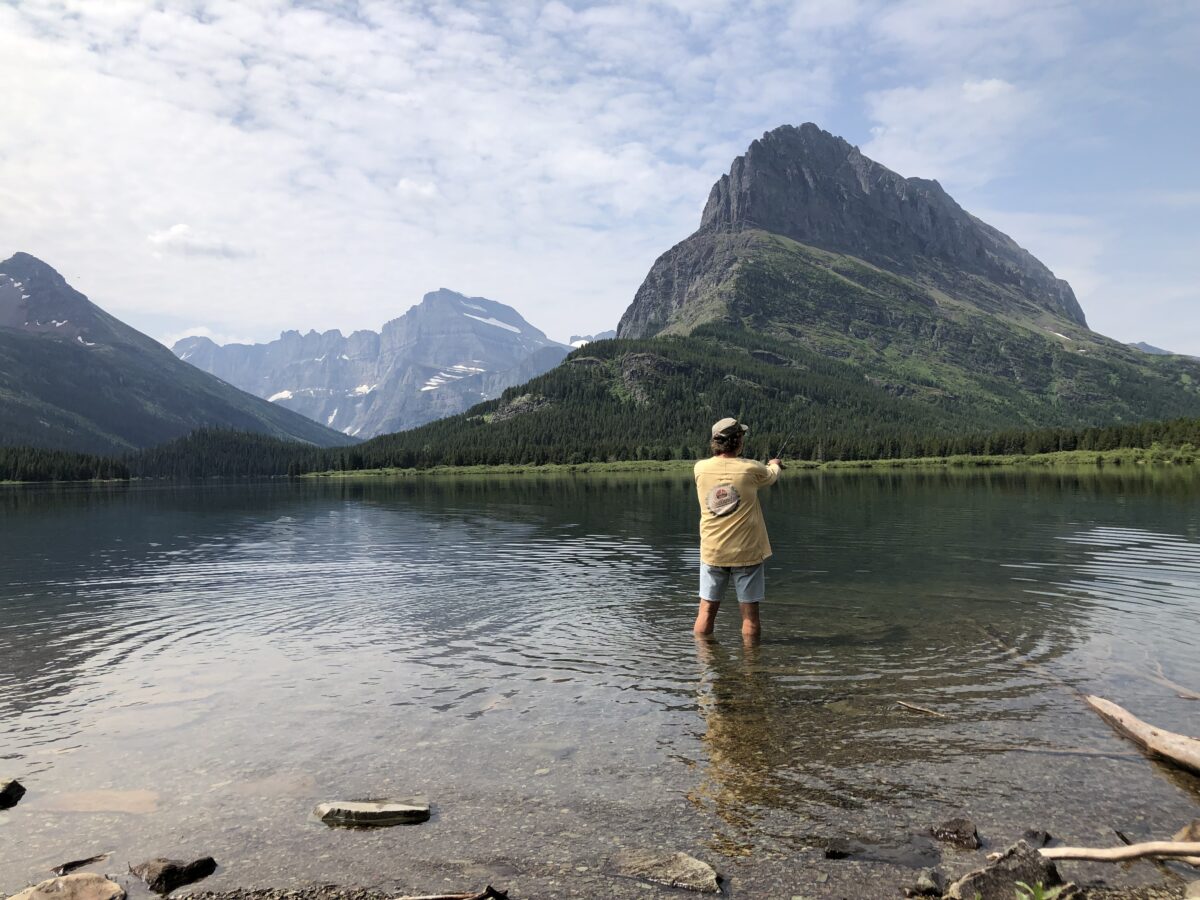
Glaciers
If you read this far in the blog, now you can clearly understand what we meant by saying that there is much more to Glacier National Park than just glaciers.
Are you trying to visit all the National Parks or National Park Units?
If your goal is to visit them, one or all, we’d love to help you strategize. Give us a call at (480) 609-3978 or drop us a note here. We always enjoy talking with people who share our passion for visiting these gems of the National Park Service.
#FindYourPark
#SeeAmericaFirst
